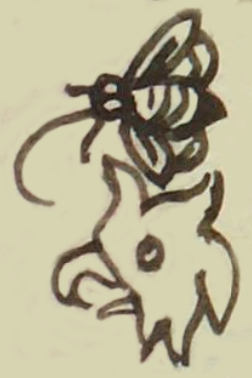Cuauhxico (MH737v)
This black-line drawing of the compound glyph for the personal name Cuauhxico (perhaps "Eagle-Bumblebee") is attested here as a man’s name. The glyph shows a bird’s eye view of a bee (xico), facing toward the viewer’s left. Below the bee is the head of an eagle (cuauhtli), with eye and beak open, and tufts of feathers on its head and neck.
Stephanie Wood
If this is not Eagle-Bee, it could be Forest-Bee, if the eagle is employed here as a phonetic indicator for Cuauh- in the sense of wood, stick, forest, etc. See below for some examples where cuauhtli (eagle) is shown as a parallel to reinforce cuahuitl (wood).
Stephanie Wood
1560
Jeff Haskett-Wood
águilas, bees, abejas, abejorros, jicotes, insects, insectos, nombres de hombres, feathers, plumas, ave, aves, pájaro, pájaros, pluma, animals, animales

cuauh(tli), eagle, https://nahuatl.wired-humanities.org/content/cuauhtli
xico(tli), large honey bee, https://nahuatl.wired-humanities.org/content/xicotli
Águila-Abejorro, o Águila-Jicote
Stephanie Wood
Matrícula de Huexotzinco, folio 737v, World Digital Library, https://www.loc.gov/resource/gdcwdl.wdl_15282/?sp=553&st=image
This manuscript is hosted by the Library of Congress and the World Digital Library; used here with the Creative Commons, “Attribution-NonCommercial-ShareAlike 3.0 License” (CC-BY-NC-SAq 3.0).








